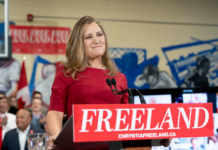A panel of Canada’s top economists gathered in Toronto to discuss the laundry list of economic problems the country is dealing with as a result of the government’s current immigration policy on Thursday.
Prime Minister Justin Trudeau’s decision to dramatically increase immigration, making it among the most open countries in the world, has created an onslaught of issues.
As people arrive in historically record numbers, they do not have the proper support they need, leading to weak productivity and higher inflation, according to several chief economists at some of Canada’s largest banks.
There was a packed audience at the Economic Club of Canada event on Thursday, many looking for answers to the difficulties brought on by Canada’s current economic state.
“Frankly I’m surprised we screwed it up because we sit in such a privileged position in Canada,” said Beata Caranci, chief economist at Toronto Dominion Bank.
Caranci noted that unlike the U.S. and other countries, Canada has not been faced with an overflow of migrants due to uncontrolled borders, but instead held the advantage of being able to think about the implications of its policies beforehand.
“We designed our own policy, we put it in place, we implemented it, and we still screwed it up,” said Caranci.
From Jan. to Oct. 1 of last year, Canada accepted about 455,000 new permanent residents and another 800,000 non-permanent residents, like international students, temporary foreign workers and refugees.
Canada now has a growth rate of 3.2%, giving it a faster growth rate than India, China, or any other G-7 nation, according to BNN Bloomberg.
While Canada does have an annual target for permanent residents, there is no cap in place for international-student permits.
Additionally, the Trudeau government has made it easier for employers to hire temporary foreign workers.
“I’ll put it bluntly: We’ve fallen into the population trap,” said Stéfane Marion, chief economist at National Bank of Canada.
According to Marion, the standard of living can no longer increase because “you don’t have enough savings to stabilize your capital to labor ratio.”
The Trudeau government has made attempts to incentivize the construction of rental housing to alleviate the housing shortage however, “the numbers just don’t add up,” said Avery Shenfeld, chief economist at CIBC Capital Markets.
“I’m a bit surprised that the government is moving fairly slowly on this. I think there’s some urgency to bring these numbers of students and temporary workers into better balance with the arithmetic of our homebuilding strategy, because the two are working at cross-purposes.”
Shenfield also noted that provinces which have restrictions on funding to post-secondary institutions, will often make up for lost revenue by bringing in international students.
This practice leads to community colleges having “branch plants” that are mostly international students in Toronto office buildings, said Shenfield.
“It’s just really a tuition-making machine.”
All of the economists agreed that the government should be more deliberate about matching the inflow of people to what Canada can actually manage, before adopting a more restrictive immigration policy.
Chief economist at Bank of Nova Scotia Jean-Francois Perrault mentioned that Canada has traditionally relied on immigration to aid businesses who complain about difficulties with hiring staff, however,“in a way we made it too easy for businesses to hire,” said Perrault.
He suggested looking into how the U.S., which has stricter policies on immigration, is able to have higher productivity.
“Immigration policy made it cheaper to bring people in rather than investing,” said Perrtault.
Bank of Montreal’s chief economist, Douglas Porter, said Canada’s terribly poor productivity and housing affordability are the two biggest issues in the Canadian economy that need to be urgently dealt with, and high population growth is a major contributing factor to both.





















